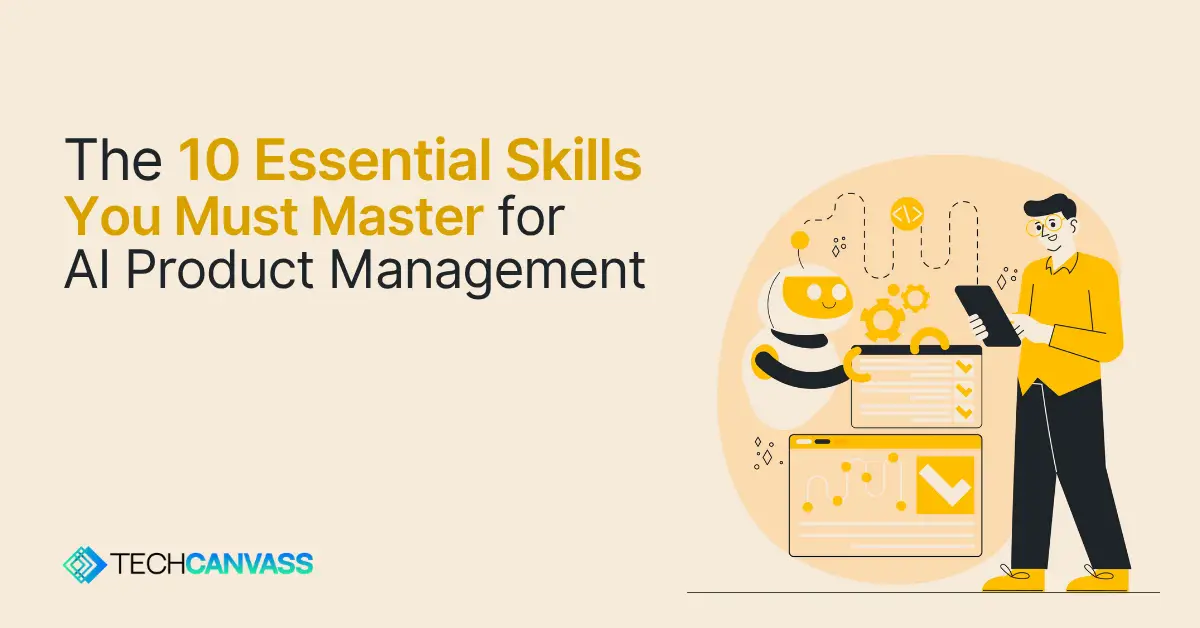Last Updated on November 13, 2025 by Techcanvass Academy
Table of Contents
Introduction (Why this matters now?)
Product management is not what it used to be. Artificial intelligence is no longer a buzzword but is starting to become the foundation of new gen products. AI has changed the game entirely, and most of the old playbooks do not fit anymore. Right from recommendation engines that you use in Netflix to predictive text in your messaging or email, AI is being used for this digital experience. This trend has led to a new kind of leader, the AI Product Manager. The role of AI PM differs from traditional PM as AI PM needs to manage probabilistic systems over deterministic systems. AI PM manages products which evolve based on new data. An AI PM hence must wear multiple hats being part strategist, part data scientist, part ethicist, and part user-advocate. This article details the essential skills you must master to lead the development of world class AI products.
AI Product Managers must operate in a world where products evolve with new data. The skills for AI Product Managers today span strategy, data fluency, ethics, and user advocacy.
Useful Links
Top Skills for AI Product Managers That Separate Good from Great
1. Get comfortable with AI basics
This is what we have learnt in our schools. We need to know our basics before we start to apply them. You cannot manage what you do not understand. An AI PM must speak the language of “data science”, and you do not need a PhD to have real conversations with your team. This is a standout skill which unlocks all other skills that you need to master. This does not mean that the AI PM must be able to code or build models but must understand core concepts.
Why it is essential?
Feasibility
If you do not understand the difference between supervised, unsupervised and reinforcement learning, you cannot have real discussions with the team about timelines, data needs and the feasibility of feature.
Collaboration
Data science teams need a PM who understand the basic terminologies such as NLP, Neural Networks, Model training, etc so that you can collaborate better with team instead of just listing the requirements what needs to be build.
Scope Limitations
An AI PM must know the boundaries of AI. They should know why models hallucinate or what model drift means for long term product success.
An AI PM must build this skill to understand key concepts such as
Supervised vs Unsupervised Learning
Knowing the difference between training a model with labelled data and asking model to find patterns in unlabelled data.
Core Terms
An AI PM must know core terms such neural network, computer vision, training dataset, etc.
Cost of AI
An AI PM must know AI models require huge amount of data and computation power which may impact the budget.
2. Think in Data
Here is the thing in AI products, your data is not just supporting the product. It is the product. In traditional software-based products, code is the primary asset where as in AI, data is the primary asset. The model is as good as the data it is trained on. Always remember if your model is trained on garbage, you should expect the output to be garbage. Hence as an AI PM it is your role to become the ultimate steward of the data. Think of AI PM who lacks data fluency is like a chef who does not know their ingredients.
Why is it essential?
-
Data Sourcing
Where will you get the data? Do you need to buy it? Does the data have bias? Do you need to create a data-generating feature?
-
Data Quality
Bad data in, bad AI out. Own data cleaning, annotation, storage — the unglamorous work that takes most of the project time.
-
Data Governance and Privacy
Be fluent with regulations like GDPR/CCPA. As AI PM, you’re the frontline defender of user privacy.
An AI PM obsessively should ask questions about data such as
-
Do we have the data?
Do we have the data we need to solve the problem for which we are building the product?
-
Labeling at Scale
How will we label this data accurately and at scale?
-
Bias & Diversity
Does this data have bias, and is the dataset diverse?
-
Data Collection & Retention
What is our data collection and retention policy?
3. Know when AI Is and Is NOT the answer
One of the common mistakes that most of the companies do is try and fit AI for every problem space. Not every problem needs an AI solution. Learning to spot the right opportunities is half the battle. An effective AI PM starts with defining the user problem and then determines if AI is the best way to solve it. This is AI problem framing.
Why is it essential?
-
Avoids Solutioneering
The goal must be to solve the user’s problem, not to force AI where it’s unnecessary. Many times a simple deterministic solution is better.
-
Define Success
AI PMs must define and measure success. Are we predicting, classifying, ranking, generating, or clustering? Each requires its own metric.
An AI PM must be the person who asks the following questions
-
Is AI Necessary?
Is AI truly required here, or can a simpler rule-based approach solve the problem?
-
User Behavior Change
How will AI change the user’s experience or behavior?
-
Real Human Problem
What is the actual human problem we are trying to solve?
4. Build things people can trust
In traditional PM ethics may be a topic handled by legal team but for an AI PM it is a core feature design and risk management function. When you build AI systems most of the decisions are automated at scale and speed at which humans cannot match. If such systems are biased, opaque or unsafe the harm they can cause is also scaled. An AI PM who ignores ethics is not just risking brand reputation they are also risking regulatory action and user abandonment. This is arguably the most difficult power skill for an AI PM as it requires moral courage. An AI PM is the one who must slow down a launch, advocate for more testing or even argue to not build a product if it cannot be made fair and safe.
Why is this essential?
-
Fairness and Bias
If your data is biased your model will learn, codify, and scale that bias.
-
Transparency
Deep learning models provide answers without clear reasoning. This is critical in high-stake domains like medicine and finance.
-
Privacy and Data Rights
AI models are data-hungry. As an AI PM, you must embed privacy-by-design and protect user trust.
Useful Links
5. Navigate the messy reality of AI development
Traditional product management operates on familiar cycle: Define requirements, design the system, test and deploy the code. This is a deterministic process. Here the code is the asset, you ship it and it remains static until the next update. On the other hand, AI product lifecycle is iterative, cyclical and probabilistic process managed by set of practices called Machine Learning Operations (MLOps). Here the model is the asset. You ship it and it can immediately start to degrade as the real world changes. This is called model drift. Example, an AI model trained to predict the housing prices on pre-2020 data would be useless in post pandemic market. The AI PM is not just managing V1 launch, you are managing a living system that is in constant state of learning and re-learning.
Why is this essential?
-
Complex and Uncertain
The MLOps lifecycle is iterative and ambiguous — success requires comfort with experimentation and building long-term learning systems.
-
Failures are Certain
AI models will fail. The question is how gracefully the product recovers — e.g., falling back to a simpler search method when needed.
-
Iteration & Feedback Loops
The first version will be weak. The AI PM must design feedback loops so the model learns over time (like Netflix recommendation tuning).
6. Experimentation and Evaluations
In traditional product management success can be easy and straightforward to measure. In AI product management standard A/B tests will not always cut it. You need to understand what reliable performance looks like for AI. Evals is a complex and multi-layered discipline.
There are two types of metrics, and mixing them up will sink your product:
-
Model Metrics
Technical measures like accuracy, precision, recall. They tell you whether the AI is functioning correctly.
-
Product Metrics
User-focused measures like engagement, retention, and conversion. They tell you whether the AI actually benefits users.
Here is the issue when AI can have perfect technical scores and still be useless to users! Example: The Fraud detector that did nothing. Say you build an AI to catch credit card fraud. Fraud happens 0.1% of the time. Your data scientist says the model is 99.9% accurate! Sounds great until you realize it just labels everything as “not fraud.”
What should an AI PM do?
-
Define Success Upfront
Before building anything, decide what matters. If false alarms annoy users, optimize for that. If missing fraud is worse, optimize for catching everything.
-
Assess Smarter
Regular A/B tests do not work for AI. Instead:
- Test on old data first
- Run the new AI alongside the old in shadow mode
- Compare results before going live
As an AI PM, you are constantly checking, does this work technically and does this help actual people? You need good answers to both, or you are just building an expensive toy.
7. Design for Humans, Not Just Algorithms
In traditional software, the interface is predictable, and the user is in control. Where as in AI, the user collaborates with the system that can be unpredictable, opaque, and sometimes just plain wrong. This creates an entirely new user interface challenge, and it is AI PM job not to just design and interface but to design a relationship built on trust.
Why is it essential?
-
Building Trust is #1 Goal
Users abandon the product if they don’t understand why AI made a decision. Transparency builds trust.
-
AI Fails Differently
AI can be confidently wrong — which can break trust far faster than a simple, familiar error message.
Here is what AI PM needs to do:
Set Expectations Immediately
Design for failure gracefully
Make feedback a core feature
Provide control and agency
Show your work (reasoning)
8. Connect the Dots to Business Value
It is quite easy to build a solution that is technically brilliant but commercially useless. Spending years and millions of dollars on R&D to build a model with state of the art, only to find it does not solve real business problem or customers will not pay for it. This where AI PM must be the strategic business anchor where you are not just the voice of customer but also voice of the business.
Why is it essential?
-
AI is Expensive
Developing models requires massive high-quality datasets, costly labeling, and rare talent.
-
Justifies R&D
AI development outcomes are uncertain. The AI PM must justify investment in terms of business value.
-
Defines Monetization
The AI PM must own how the product makes money and define the business case from day one.
9. Become the Translator-in-Chief
AI PM is the bridge between engineers, designers, executives, and users. Everyone speaks a different language, and you need to speak to them all.
Why is it essential:
-
Bridging the Chasm
The technical and business teams speak different languages. The AI PM prevents misalignment and costly misunderstandings.
-
Managing Stakeholders
AI triggers hype for leadership and overwhelm for engineers. The AI PM balances reality, expectations, and delivery timelines.
10. Make Peace with Uncertainty
This final skill is the most abstract but an essential one. It is a fundamental shift in mindset. Traditional software systems are deterministic. If the user clicks this to do that the outcome is 100% predictable. AI systems are probabilistic. Things will not always work perfectly. AI PM must be comfortable with mostly right and learn to manage risk accordingly.
Useful Links
Real-World Skills for AI Product Managers in Action
Bottom Line: You are not just managing products anymore..
The transition from traditional to AI powered or AI native product management is profound as the shift from desktop to mobile. As an AI PM, you are orchestrating something much bigger bringing together technology, people, ethics, and business in ways that work in the real world. This is without question the most challenging and exciting role in technology today!
Frequently Asked Questions About AI Product Management Skills
Q. What are the most important AI Product Management skills?
A. AI PMs must understand data, model behavior, user needs, and how AI systems evolve over time.
Q. What is the role of an AI Product Manager?
A. An AI PM bridges business, data science, design, and engineering to build AI-driven products that deliver real user value.
Q. What competencies does an AI PM need to succeed?
A. Key competencies include understanding ML basics, data quality, experimentation, ethical considerations, and stakeholder alignment.
Q. Do product managers need to know machine learning?
A. Yes, they must understand core ML concepts well enough to discuss feasibility, timelines, and trade-offs with data teams.
Q. How do AI PMs make data-driven product decisions?
A. They rely on user feedback, model performance metrics, and product usage patterns to continuously refine the system.
Q. What does the AI product lifecycle look like?
A. It is iterative, starting with data collection → model training → deployment → monitoring → continuous learning.
Q. How does MLOps relate to product management?
A. AI PMs coordinate with MLOps to ensure models are deployed reliably, monitored continuously, and retrained when needed.
Q. Why is ethical AI design important?
A. Without fairness and transparency, AI systems can reinforce bias and damage user trust, especially in high-impact domains.
Q. What is AI governance and why does it matter?
A. It ensures models follow privacy laws, handle sensitive data responsibly, and remain accountable over time.
Q. What belongs in a Product Manager’s AI toolkit?
A. Understanding dataset quality, evaluation metrics, experimentation frameworks, and how to design human feedback loops.




